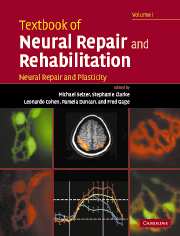Book contents
- Frontmatter
- Contents
- Contents (contents of Volume II)
- Preface
- Contributors (contributors of Volume I)
- Contributors (contributors of Volume II)
- Neural repair and rehabilitation: an introduction
- Section A Neural plasticity
- Section A1 Cellular and molecular mechanisms of neural plasticity
- Section A2 Functional plasticity in CNS system
- Section A3 Plasticity after injury to the CNS
- Section B1 Neural repair
- Section B2 Determinants of regeneration in the injured nervous system
- Section B3 Promotion of regeneration in the injured nervous system
- 25 Cell replacement in spinal cord injury
- 26 Dysfunction and recovery in demyelinated and dysmyelinated axons
- 27 Role of Schwann cells in peripheral nerve regeneration
- 28 Transplantation of Schwann cells and olfactory ensheathing cells to promote regeneration in the CNS
- 29 Trophic factor delivery by gene therapy
- 30 Assessment of sensorimotor function after spinal cord injury and repair
- Section B4 Translational research: application to human neural injury
- Index
25 - Cell replacement in spinal cord injury
from Section B3 - Promotion of regeneration in the injured nervous system
Published online by Cambridge University Press: 05 March 2012
- Frontmatter
- Contents
- Contents (contents of Volume II)
- Preface
- Contributors (contributors of Volume I)
- Contributors (contributors of Volume II)
- Neural repair and rehabilitation: an introduction
- Section A Neural plasticity
- Section A1 Cellular and molecular mechanisms of neural plasticity
- Section A2 Functional plasticity in CNS system
- Section A3 Plasticity after injury to the CNS
- Section B1 Neural repair
- Section B2 Determinants of regeneration in the injured nervous system
- Section B3 Promotion of regeneration in the injured nervous system
- 25 Cell replacement in spinal cord injury
- 26 Dysfunction and recovery in demyelinated and dysmyelinated axons
- 27 Role of Schwann cells in peripheral nerve regeneration
- 28 Transplantation of Schwann cells and olfactory ensheathing cells to promote regeneration in the CNS
- 29 Trophic factor delivery by gene therapy
- 30 Assessment of sensorimotor function after spinal cord injury and repair
- Section B4 Translational research: application to human neural injury
- Index
Summary
Traumatic spinal cord injury (SCI) results in devastating and often permanent disability for which no effective biologic therapies exist. The injury initiates a cascade of complex, interrelated pathologic processes leading not only to cell death at the injury site and in higher brain centers but also to the severing, demyelination and physiologic inactivation of axons and the generation of an environment hostile to neural repair. Numerous studies have increased our understanding of why regeneration fails following SCI and documented promising experimental interventions to overcome this failure. Advances in our knowledge of stem cell biology over the past decade have raised hopes that grafts with the potential to differentiate into subsets or all the major cells of the spinal cord will be able to replace neurons and glial cells that have been destroyed or rendered dysfunctional by injury. The isolation and characterization of stem cells and lineage-restricted precursors from multiple regions in the developing and adult central nervous system (CNS), as well as from tissue outside the nervous system, bring these expectations closer to reality (see Volume I, Chapter 18). In addition, the discovery of endogenous precursor cells in the adult spinal cord revealed another source of cells that may be amenable to therapies. These ideas have captured the imagination because, although we are only beginning to understand the promises and pitfalls of this approach, the need for effective treatments for SCI is urgent (see Volume II, Chapter 37).
Keywords
- Type
- Chapter
- Information
- Textbook of Neural Repair and Rehabilitation , pp. 445 - 467Publisher: Cambridge University PressPrint publication year: 2006
- 2
- Cited by



